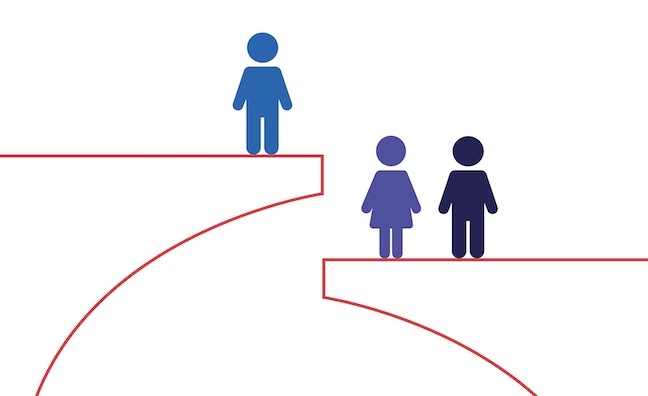It’s the sixth year of gender pay gap reporting and, with today’s deadline (April 4) for the latest results, the industry will be looking at the progress made so far.
The initial results made sobering reading and music companies have issued annual updates on their efforts to improve the pay gap. There has been an increased focus on achieving parity in terms of remuneration based on the company-wide average, but the pay gap has remained stubbornly wide for companies over that period.
The latest pay gap figures for 2022-23 provide a snapshot based on pay on April 5, 2022, so the situation could have improved further since then. All three majors are required to report their figures, which applies to companies with 250 or more employees.
Here, Music Week analyses the available figures so far. This story will be updated as more data becomes available from companies reporting their pay gap figures.
Universal Music UK
Based on the snapshot date of April 5, 2022, Universal Music UK has a median gender pay gap of 25% (27.3% in 2022) and a mean (average) pay gap of 25.6% (31% in 2022).
According to the 2023 Universal Music UK snapshot, women occupy 28% of the highest paid jobs and 57% of the lowest paid jobs.
Bonus pay at the major went to 76% of women, and 81% of men. The median bonus pay gap is 57.2%, while the mean (average) bonus pay gap is 61.8%. In the prior year, women’s median bonus pay was 47.7% lower than men’s, while mean bonus pay was 59.3% lower.
Universal Music’s report was signed by Peter Wheeldon (SVP, people, inclusion & culture, Universal Music Group) and Natasha Mann (director of diversity and inclusion, Universal Music UK).
In an overview, the major said: “In many ways, we’ve achieved real progress. We now have more women than men working at our record labels and six of our business units are led by women. This reflects a steady increase in the number of women moving up through the organisation to more senior roles at Universal Music UK. Nevertheless, looking across all Universal Music employees working in the UK, we still have a headline Gender Pay Gap figure of 25.6%. This figure – reflecting the difference in the average (“mean”) pay of all men and women in the organisation – is an improvement on the 31.0% we reported in 2022, but clearly there is more to be done.”
It continued: “The figures we are reporting today include every team and function of our business based in the UK and while we have gender balance across our frontline labels, this is not the case in every part of the company. There are a number of areas in our business where women are under-represented, and we are further focusing our efforts to redress this imbalance.”
Universal cited examples of its “ongoing work” to enhance all forms of diversity, equity and inclusion with its initiatives in place to support the careers and progression of women at Universal Music. These include its Women In A&R programme, mentoring and training, “Bystander to Upstander” training, personalised support around fertility, pregnancy and early parenthood, menopause support, new workplace policies and its Women’s Network.
“The actions we’re taking are helping us make real progress but we are disappointed this isn’t more visible in the gender pay gap measure,” said the major. “We won’t rest until the work is done.”
Sony Music UK
Based on the snapshot date last April, Sony Music Entertainment UK has a median gender pay gap of 15.9% (15% in 2021) and a mean (average) pay gap of 20% (27.9% in 2021).
At Sony Music, women occupy 38.9% of the highest paid jobs and 62.6% of the lowest paid jobs. However, more women receive a bonus (75.3%) than men (64.1%).
The median bonus pay gap is 22.6%, while the mean is 49.4%. In the prior year, the median figure was 22.1%, while the mean was 57.8%.
Sony has also reported ethnicity pay gap figures. The major said 25% of its employees are Black, Asian or from another ethnic minority. The median ethnicity pay gap at Sony Music is 3.5%, while the mean is 1.2%.
In its gender pay report signed by CEO & chairman Jason Iley, COO Nicola Tuer and Liz Jeffery, VP of human resources, Sony Music highlighted its landmark policy of childcare support, as well as measures including equal parental leave policy, its A&R Academy plus mentoring and skills initiatives.
“At Sony Music UK we believe creativity is a product of diversity,” said the statement. “We strive to bring together the best talent and provide everyone in our business with the opportunity to thrive.
“Our goal is to be the destination company for the most creative talent in the entertainment industry – where every employee and creator feels they belong and can fulfil their potential in a supportive, diverse, and inclusive environment.”
Warner Music UK
Warner Music UK issued its figures ahead of the deadline date of April 4.
Based on the snapshot date of April 5, 2022, Warner Music UK has a median gender pay gap of 13.6% (17.8% in 2021) and a mean (average) pay gap of 37.7% (36.7 % in 2021).
The median gender pay gap has come down from 21% in 2017, while mean is down from 49% that year.
According to the 2022 Warner Music snapshot, women occupy 32% of the highest paid jobs and 52% of the lowest paid jobs.
Bonus pay at the major went to 83% of women and 88% of men. The median bonus pay gap is 6.4%, while the mean (average) bonus pay gap is 55.8%. In the prior year, the median bonus pay gap was 20.6%; the mean (average) bonus pay gap was 65.6%.
In an overview signed by Warner Music CEO Tony Harlow, VP, people team, Erica Bone and Dr Maurice Stinnett, global head of diversity, equity & inclusion, the major highlighted its policies to improve the pay gap.
“The figures show an overall pattern of progress, but it’s not been linear, and we’re open about the fact that this process is a marathon and not a sprint,” said the statement.
Warner Music UK has a target of increasing female representation in combined senior and executive positions to 50% by the end of 2025.
Senior promotions in the last 12 months included Linda Walker’s elevation to SVP, commercial, Europe and Charlotte Saxe’s appointment as SVP, legal and business affairs.
Action taken includes family-friendly policies for parents and caregivers; changes in recruitment to remove bias and improve outreach; partnering with the Women Of Warner Employee Resource Group; and training and education to help managers lead more inclusively.
Separately, Warner Music International has issued its first report after crossing the staffing threshold. It reported a median gender pay gap of 24.3% and a mean pay gap of 38.4%.
PRS For Music
PRS For Music has a median pay gap of 20.3% (25.3% in 2021) and a mean (average) pay gap of 14.5% (10.6% in 2021).
In 2017, the median pay gap was 11.5% and the mean was 17.2%.
At PRS, women occupy 35% of the highest paid jobs (including Andrea Czapary Martin as CEO) and 51% of the lowest paid jobs.
More women than men received a bonus - 22% compared to 20%.
When it comes to bonus pay, the median result is a 49.8% pay gap and the mean (average) is a 70.4% bonus pay gap. In the prior year, the median bonus pay gap was 45.8% and the mean was 29.8%.
PRS also published ethnicity pay gap figures showing a reduction to 14.6% median (26.3% in 2021) and 17.6% mean (20% in 2021).
The collection society’s action plan includes apprenticeships, targets and reporting, and working with EDI affinity groups.
Andrea Czapary Martin, CEO, PRS For Music, said: “The report evidences how far we have come in our journey of change, but also how far we still need to travel. Despite the establishment of strong foundations and progress in some key areas, we know further endeavours are needed. Although be assured our commitment is unwavering.
“Over the next year we will continue to work closely with the UK Music Diversity Taskforce to ensure we build a music industry which embraces diversity and inclusion and treats everyone fairly and equitably.”
Suzanne Hughes, chief people and transformation officer, PRS For Music, added: “This year’s report shows that the year-on-year comparisons are complicated by the impact of the pandemic, not least because the regular company bonus scheme did not run. However, we are delighted to have increased the proportion of women in senior roles over the last year. There is also clear evidence that we are reducing the ethnic pay mean and median gap which is positive.”
AEG
Live music giant Anschutz Sports Holdings, parent company of The O2 and AEG Presents, has reported its figures.
AEG has reported a median gender pay gap of 31.9% (11% in 2021) and a mean (average) pay gap of 37.5% (22% in 2021).
In 2017, the median pay gap was 41.2% and the mean was 43.3%.
Women occupy 36% of the highest paid jobs and 73% of the lowest paid jobs at AEG.
There was a difference of 10 percentage points in terms of those who received bonuses - 26% of women and 36% of men.
AEG’s median bonus pay gap is 32.5% and the mean (average) bonus pay gap is 66.1%. In the prior year, the median bonus pay gap was 23.1% and the mean was 53.2%.
“We acknowledge that there remains much to be done to continue to narrow the gender pay gap, whilst recognising the steady, positive impact that our ED&I strategy has had since we began reporting in 2017,” said AEG’s statement. “Our employees are at the heart of everything we do at AEG, and we remain steadfastly committed to creating a truly equal and supportive environment where every individual can thrive.”
Actions taken by AEG include a mentoring programme and revising its family-friendly policies.
PPL-PRS
The good news is that PPL-PRS has no gender pay gap (in fact, the balance is slightly in favour of women). The Leicester-based licensing organisation has a median pay gap of 0.9% in favour of women and the same result for mean (average). That marked an improvement on 2021’s result, which showed a slight bias in favour of men in terms of pay.
At PPL-PRS, women occupy 50% of the highest paid jobs (including MD Andrea Gray) and 50.7% of the lowest paid jobs.
Slightly more women than men received bonuses (69.1% compared to 68.4%).
Women’s bonus pay is higher too: median (32.2%) and mean (37.7%).

 FOLLOW
FOLLOW 







